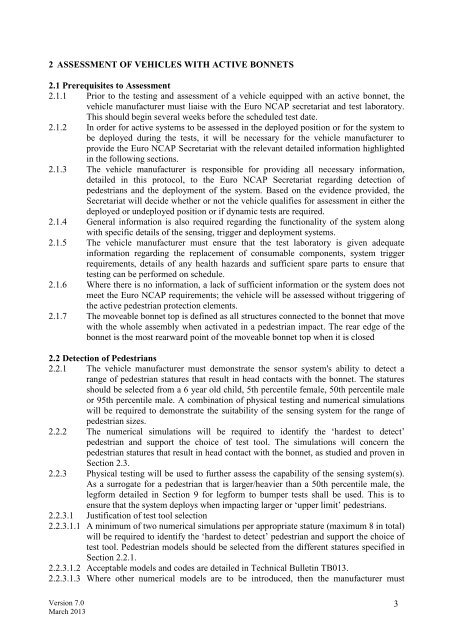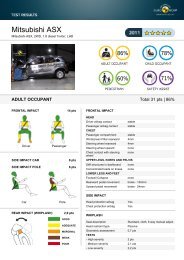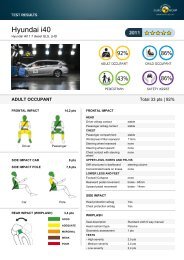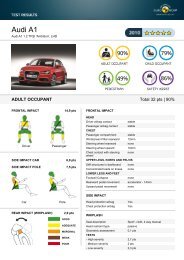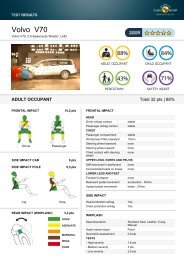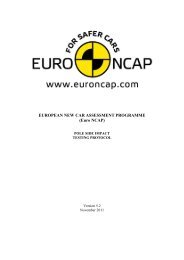Pedestrian Test Protocol - Euro NCAP
Pedestrian Test Protocol - Euro NCAP
Pedestrian Test Protocol - Euro NCAP
Create successful ePaper yourself
Turn your PDF publications into a flip-book with our unique Google optimized e-Paper software.
2 ASSESSMENT OF VEHICLES WITH ACTIVE BONNETS<br />
2.1 Prerequisites to Assessment<br />
2.1.1 Prior to the testing and assessment of a vehicle equipped with an active bonnet, the<br />
vehicle manufacturer must liaise with the <strong>Euro</strong> <strong>NCAP</strong> secretariat and test laboratory.<br />
This should begin several weeks before the scheduled test date.<br />
2.1.2 In order for active systems to be assessed in the deployed position or for the system to<br />
be deployed during the tests, it will be necessary for the vehicle manufacturer to<br />
provide the <strong>Euro</strong> <strong>NCAP</strong> Secretariat with the relevant detailed information highlighted<br />
in the following sections.<br />
2.1.3 The vehicle manufacturer is responsible for providing all necessary information,<br />
detailed in this protocol, to the <strong>Euro</strong> <strong>NCAP</strong> Secretariat regarding detection of<br />
pedestrians and the deployment of the system. Based on the evidence provided, the<br />
Secretariat will decide whether or not the vehicle qualifies for assessment in either the<br />
deployed or undeployed position or if dynamic tests are required.<br />
2.1.4 General information is also required regarding the functionality of the system along<br />
with specific details of the sensing, trigger and deployment systems.<br />
2.1.5 The vehicle manufacturer must ensure that the test laboratory is given adequate<br />
information regarding the replacement of consumable components, system trigger<br />
requirements, details of any health hazards and sufficient spare parts to ensure that<br />
testing can be performed on schedule.<br />
2.1.6 Where there is no information, a lack of sufficient information or the system does not<br />
meet the <strong>Euro</strong> <strong>NCAP</strong> requirements; the vehicle will be assessed without triggering of<br />
the active pedestrian protection elements.<br />
2.1.7 The moveable bonnet top is defined as all structures connected to the bonnet that move<br />
with the whole assembly when activated in a pedestrian impact. The rear edge of the<br />
bonnet is the most rearward point of the moveable bonnet top when it is closed<br />
2.2 Detection of <strong>Pedestrian</strong>s<br />
2.2.1 The vehicle manufacturer must demonstrate the sensor system's ability to detect a<br />
range of pedestrian statures that result in head contacts with the bonnet. The statures<br />
should be selected from a 6 year old child, 5th percentile female, 50th percentile male<br />
or 95th percentile male. A combination of physical testing and numerical simulations<br />
will be required to demonstrate the suitability of the sensing system for the range of<br />
pedestrian sizes.<br />
2.2.2 The numerical simulations will be required to identify the ‘hardest to detect’<br />
pedestrian and support the choice of test tool. The simulations will concern the<br />
pedestrian statures that result in head contact with the bonnet, as studied and proven in<br />
Section 2.3.<br />
2.2.3 Physical testing will be used to further assess the capability of the sensing system(s).<br />
As a surrogate for a pedestrian that is larger/heavier than a 50th percentile male, the<br />
legform detailed in Section 9 for legform to bumper tests shall be used. This is to<br />
ensure that the system deploys when impacting larger or ‘upper limit’ pedestrians.<br />
2.2.3.1 Justification of test tool selection<br />
2.2.3.1.1 A minimum of two numerical simulations per appropriate stature (maximum 8 in total)<br />
will be required to identify the ‘hardest to detect’ pedestrian and support the choice of<br />
test tool. <strong>Pedestrian</strong> models should be selected from the different statures specified in<br />
Section 2.2.1.<br />
2.2.3.1.2 Acceptable models and codes are detailed in Technical Bulletin TB013.<br />
2.2.3.1.3 Where other numerical models are to be introduced, then the manufacturer must<br />
Version 7.0<br />
March 2013<br />
3


